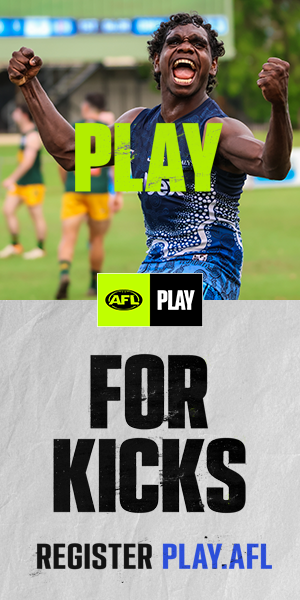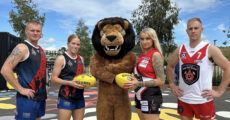The following is an excerpt from More of the Kangaroo: 150 Years of Australian Football in Queensland.
You can purchase your copy of the book here.
More of the Kangaroo will be officially launched on December 11 at Coorparoo AFC. Find out more information here.
Darling Downs – Part One
(excerpt from More of the Kangaroo – 150 years of Australian football in Queensland – 1866 to 2016)
Darling Downs – Australian football pacesetters in the 19th century
One of the first football associations in the world – and in Australia – was an Australian football league – the Toowoomba Football Association when in formed in 1876.
In 1873 the first regional football clubs in Queensland were established on the Darling Downs, and after some debate they decided to play under what were by then called the “Victorian rules”. At that stage, only Queensland and Victorian clubs were regularly playing under the rules that had been formulated in Melbourne by Tom Wills and others in 1858.
The first Downs clubs were inaugurated in Toowoomba and Warwick. John Boyce was a Geelong schoolboy associate of Cedric and Horace Wills, younger brothers of the famous sportsman Tom Wills. After moving north to Queensland in the late 1860s, Boyce initially played Victorian rules for the Brisbane club before becoming involved in the establishment of the code on the Downs.
The original Toowoomba football club wore yellow uniforms and were known as the Canaries. The Warwick club instituted “town” memberships for those living in the town and “country” memberships for players from out of town; Town would regularly play Country.
In 1874, the Warwick Argus reported on Queensland’s first “football carnival”. Warwick played against “the Brisbane and Ipswich clubs in Toowoomba”. In one match during the 1874 season, Toowoomba defeated Brisbane by four goals to nil. (Behinds were not recorded until a few years hence and low scoring was a feature.)
After a hesitant beginning, Victorian rules on the Downs gained momentum in 1876 with at least four clubs being active – Light Infantry, Civil Service, Toowoomba and Warwick. These clubs formed one of the first football associations in the world and the first Australian football association in Australia – the Toowoomba Football Association.
The Sydney-based Southern Rugby Union, formed in 1874, was the only other football association in Australia in any code at that time. The Victorian Football Association and South Australian Football Association were inaugurated in 1877. The Brisbane and Ipswich clubs waited until 1880 to form the Queensland Football Association.
The Darling Downs Gazette reported on the inaugural TFA match:
The first football match of the season was played last Saturday afternoon, on the ground opposite the Congregational Church, Margaret Street. The Civil Service Club having invited the Toowoomba Club and any other “old kickers” to join them, a capital muster was secured . . . Several of the players presented an amusing appearance, marked as they were with the scars of many a gallant tussle and fall . . . The play throughout was conducted with extreme animation and spirit . . . The Victorian rules were observed.
A Warwick journalist, when reporting on a Toowoomba-Warwick match, outlined some of the difficulties for the TFA. With men from all over Australia converging on the Downs, gaining consensus on the rules of play was a problem.
One player was evidently under the impression that he was playing under the ‘rugby’ rules;
another went in for the ‘rugby union’ rules; while others for the ‘Victorian’ rules’…it was evident that some alterations were badly wanting . . . [otherwise] . . . football will come to a standstill on the Downs.
Football in Warwick was obviously thirsty work. The Queensland Figaro noted that at half-time of one match, both teams adjourned to the nearest hotel for a “wet”.
The confusion over the rules was a contributing factor to football faltering for a few years, but by the early 1880s, Toowoomba, Warwick and Allora (35 miles south of Toowoomba) were again playing by the Victorian rules.
Henry Ludgate played with the Ipswich club in the first intercity matches in Queensland, way back in 1870. He and Francis North, a former Australian football player at Ipswich Grammar, were founders of the Allora club. Allora wore a pink and white-hooped guernsey and pink knickerbockers. The Warwick Argus, when reporting on a victory for Allora, noted that their best players were: “Thorpe, White, Alford and the Darky”. The Allora player unfortunately identified as “the Darky” may well have been one of the first Aborigines to play Australian football in Queensland.
Former Ipswich footballers were also spreading the Victorian rules to the wide-open spaces to the west of Toowoomba. The Queensland Figaro reported that: “Cunnamulla is to the front in the noble game, a match being played there lately . . . Among the players, I notice names . . . [that] have played for the Ipswich Grammar School for some years.”
Before long, the code had spread to other western centres like Adavale, Roma, Thargomindah and Stanthorpe.
By 1883, most of the schools on the Downs were playing Australian football with Toowoomba Grammar also playing yearly return matches with Brisbane Grammar and Ipswich Grammar.
Billy ‘Chang’ O’Carroll, from the Excelsiors club in Brisbane, played a hand in the development of club football in Toowoomba. The Toowoomba club’s predecessor, the Canaries, had folded and a new entity, the Red Mud, had been formed. O’Carroll organised a combined Brisbane team to travel to the Darling Downs early in the 1883 season to take on the Red Mud.
In August 1884, Queensland’s first inter-colonial Australian football representative team narrowly defeated New South Wales in two matches played in Brisbane before the southerners travelled west to play the Ipswich Blue and Blacks and the Toowoomba Red Mud.
James ‘Jim’ Tolmie captained the Red Mud and Littleton Groom was one of Toowoomba’s best players. Tolmie was a schoolteacher and then a newspaper proprietor before he served in the Queensland Parliament for two decades. He was born on a passenger ship only days before his parents arrived in Brisbane from England in the late 1860s. Orphaned in his teenage years, Tolmie raised his eight younger siblings. Somehow he also found time to become one of the best sportsmen on the Downs in the 19th century.
Billy Goer, a former Carlton champion in the VFA who had previously represented Victoria, was the captain of NSW. Toowoomba’s clash with NSW was one of the biggest sporting events to be held on the Downs to that point. Seven hundred spectators gathered at the Aubigny Cricket Ground to see the Red Mud stick with their opponents all match. With two minutes remaining, Toowoomba’s Charrington goaled to bring the locals level, sending the crowd into raptures. The visitors rallied to score the final goal of the match and NSW 3.7 defeated Toowoomba 2.6.
William Groom, father of Littleton Groom, was the president of the Red Mud. Early in the 20th century, Groom Snr became the only ex-convict to serve in the Federal Parliament.
Soon after playing for the Red Mud in 1884, Littleton Groom migrated to Melbourne to study law, where he also played for University in the VFA (the premier Victorian competition before the Victorian Football League was formed in 1896). Young Groom, a former captain of the Toowoomba Grammar Australian football team, was to later serve for 34 years in the Federal Parliament. He was appointed as the Attorney General and Speaker of the House, and was ultimately knighted, to become Sir Littleton Groom.
At the commencement of the 1886 season, rugby officials from Brisbane approached the Red Mud about defecting from Australian football. When reporting on the Toowoomba club’s annual meeting The Brisbane Courier noted that “. . . an animated discussion took place to decide which of the two games the club should play – rugby or the [Victorian] Association game.” One member moved “. . . that the club sever its ties with the
Queensland Football Association and join the Northern Rugby Union”. The motion was narrowly lost and Toowoomba played Australian football in 1886, but in 1887 they became affiliates of the NRU. During the following three seasons, most regional centres switched their code of preference to rugby.
The code was revived in the 1910s, and again in the 1920s and during the 1940s in Warwick, but its true modern beginnings were not until 1970 when the Darling Downs Australian Football League was formed.
You can purchase your copy of the book here.
At over 1100 pages, More of the Kangaroo is a comprehensive history and cover the trajectory of the code throughout the state. It will include over 500 images and reveal facts about the evolution of the code at local level that are little known secretes in contemporary times.





















































